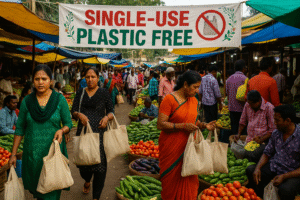Recently, I had the pleasure of visiting Coorg, often hailed as the ‘Scotland of India’, where the lush landscapes are as renowned as its coffee plantations. Amidst this verdant paradise, I stumbled upon an ecological treasure – the silver oak trees. Towering amidst the coffee shrubs, these trees were not just monumental in size but in their contribution to the plantation’s ecosystem and beyond.
Finding and Learning about Silver Oak Trees
The encounter with silver oak trees during the visit was serendipitous. Guided by the local planters, I delved into the symbiotic relationship these trees share with coffee plants. Silver oaks are not merely arboreal giants but pivotal elements in the ecological tapestry of Coorg. They serve as protective canopies for the coffee bushes, shielding them from the harsh sunlight while providing a structured habitat for diverse fauna.
 Environmental Benefits of Silver Oak Trees
Environmental Benefits of Silver Oak Trees
Silver oak trees are not just pivotal for their ecosystem services; they are also incredibly efficient at oxygen production. It is estimated that these trees can contribute to 90% oxygenation in their vicinity, making them vital in combating air pollution and enhancing air quality. This ability to produce a high amount of oxygen, coupled with their role in enhancing biodiversity, soil conservation, and water management, underscores their environmental significance.
Requirements for Silver Oak Plantation and National Expansion
- Plantation Requirements
Silver oak trees require certain conditions to thrive:
- Climate: They are best suited to tropical and subtropical climates, like those in Coorg.
- Soil: Well-drained, fertile soil with a neutral to slightly acidic pH is ideal.
- Watering: Regular watering is necessary, especially in the early stages of growth. Mature trees are relatively drought-tolerant.
- Spacing: Adequate space is needed between trees to accommodate their wide canopy and root system.
- Potential for Nationwide Cultivation
Expanding the cultivation of silver oak trees beyond Coorg could have numerous benefits for the environment and local economies across India. Given their adaptability to various climates and soil types, silver oaks could potentially be integrated into diverse agricultural landscapes. However, the feasibility of such expansion would require detailed environmental impact assessments to ensure that they would positively interact with local ecosystems and not disrupt existing biodiversity.
Economic Benefits
Economically, silver oak trees are a boon to Coorg’s coffee industry. They not only improve the quality of coffee by providing necessary shade but also contribute to the longevity of coffee plants, ensuring sustainable crop yields over the years. Additionally, silver oaks have a commercial value of their own; their wood is highly sought after in the furniture and construction industries. This dual-purpose nature makes them a valuable asset, enhancing the financial stability of coffee farmers and boosting the local economy. By integrating silver oaks into various agroforestry systems, there could be an increase in sustainable timber production, which would not only support the furniture and construction industries but also promote environmental stewardship on a broader scale.
Social Impacts
On a social level, the cultivation and maintenance of silver oak trees have significant positive impacts. They provide employment opportunities in both the coffee and timber sectors, supporting local livelihoods. Furthermore, the presence of these trees fosters a sense of community as they are often planted and cared for collectively. Educational programs focused on sustainable agriculture and environmental conservation are also enriched by the practical examples set by silver oak trees, offering valuable lessons in coexistence and resource management.
Conclusion
Reflecting on my visit to Coorg, the discovery of silver oak trees underscored a profound lesson in ecological and socio-economic interdependence. These majestic trees are more than just a feature of the landscape; they are vital contributors to the environmental health, economic prosperity, and social well-being of the region. Their role in sustaining the delicate balance of Coorg’s coffee plantations serves as a compelling example of how traditional agricultural practices can harmonize with nature to create a sustainable and prosperous future.
Author’s Note
Thank you for joining me on this enlightening journey through the lush landscapes of Coorg, discovering the invaluable silver oak trees. My visit was a revelation of nature’s intricate designs and how traditional practices can lead to sustainable living. I hope this article inspires awareness and appreciation for these ecological marvels and their role in our environment.
G.C., Ecosociosphere contributor.
References and Further Reading
- “Conserving native trees in the coffee agroforestry landscape of Kodagu” by Coorg.com explores the popularity of silver oak trees in agroforestry, particularly in Kodagu (Coorg), due to their fast growth rate and utility in providing shade for coffee plantations.
- “Shade Coffee And Ecological Integrity” by EcoFriendly Coffee emphasizes the importance of ecological integrity in coffee plantations, mentioning the shift from native to exotic trees like silver oak in recent years.




